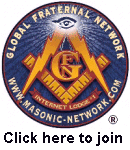
The GFN Treasure Chest Archives
www.masonic-network.com
"Where Master Masons Communicate"

 |
The GFN Treasure Chest Archiveswww.masonic-network.com |
 |
"Lodge Origins: The Hermetic Contribution
Three glimpses of the early history of what is now called Freemasonry show what was happening:
In 1638, a long, highly erudite, and amazingly bad poem titled 'The Muses Threnodie' was published in Edinburgh, containing the first recorded reference to what we would now call Masonic secrets. . . . The Mason Word, the secret sign by which members of Scottish stonemasons' lodges could recognize each other, is here identified as something magical, like the mysterious Rosicrucian movement and the second sight of Highland seers.
Three years later, on May 20, 1641, the records of the stonemasons' lodge in Edinburgh report the admission to membership of one Sir Robert Moray. Moray was not a stonemason; he was a practicing alchemist and a student of Hermetic traditions, and later became one of the founding members of the Royal Society, the great English scholarly organization which helped jump-start the scientific revolution.
Five years after that, on October 16, 1646, Elias Ashmole wrote in his diary that he and his cousin were among those initiated into a lodge of masons at Warrington in Lancashire. Ashmole was not a stonemason either; he was a student of magic and alchemy. . . and later on he became another of the founding members of the Royal Society.
What was under way in each of these cases can best be described as a spectacular case of mistaken identity. In England and Scotland, a number of educated men interested in the traditions of Hermetic magic had discovered the stonemasons' lodges in their communities, and had leapt to the conclusion that these lodges were a survival of secret traditions of initiation handed down from the distant past.
How did this happen? The fine details aren't clear, but the overall context is. Some of the factors were [only the section headings will be listed here]: The prevailing mythology of secret societies. . . The Hermetic respect for practical knowledge. . . The legacy of Vitruvius. . . The origin myth of the masons' guilds. . . .
All these factors and others, helped create an atmosphere in which a stoneworkers' craft organization could be mistaken for the remnant of an ancient initiatory tradition, and could begin to attract members whose interests lay not in the building trades but in symbolism, ritual and magic. Once this happened, the lodge structure used by masons' lodges and similar groups came to be seen as the proper way in which such traditions should be organized. At the same time, the Hermetically inclined gentlemen who became the first 'accepted Masons' did not come to this odd relationship empty-handed; they brought with them the mental furniture of the Western magical and Hermetic traditions, and above all the dazzling use of visual images, symbols and emblems central to Renaissance magic. The ceremonial life of working stonemasons before the Hermetic influx seems to have involved few or no symbolic images and very simple ritual methods. From this point on, though, the use of emblems and an effective grasp of the inner mechanics of ritual became a common feature of the whole spectrum of lodge organizations."